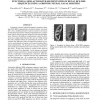Free Online Productivity Tools
i2Speak
i2Symbol
i2OCR
iTex2Img
iWeb2Print
iWeb2Shot
i2Type
iPdf2Split
iPdf2Merge
i2Bopomofo
i2Arabic
i2Style
i2Image
i2PDF
iLatex2Rtf
Sci2ools
ICASSP
2008
IEEE
2008
IEEE
Functional semi-automated segmentation of renal DCE-MRI sequences
In dynamic contrast-enhanced magnetic resonance imaging (DCE-MRI), segmentation of internal kidney structures like cortex, medulla and pelvo-caliceal cavities is necessary for functional assessment. Manual segmentation by a radiologist is fairly delicate because images are blurred and highly noisy. Moreover the different compartments cannot be delineated on a single image because they are not visible during the same perfusion phase for physiological reasons. Nevertheless the differences between temporal evolution of contrast in each anatomical region can be used to perform functional segmentation. We propose to test a semi-automated split and merge method based on time-intensity curves of renal pixels. Its first step requires a variant of the classical Growing Neural Gas algorithm. In the absence of ground truth for results assessment, a manual anatomical segmentation by a radiologist is considered as a reference. Some discrepancy criteria are computed between this segmentation and t...
Functional Segmentation | ICASSP 2008 | Manual Anatomical Segmentation | Manual Segmentation | Signal Processing |
| Added | 30 May 2010 |
| Updated | 30 May 2010 |
| Type | Conference |
| Year | 2008 |
| Where | ICASSP |
| Authors | Beatrice Chevaillier, Yannick Ponvianne, Jean-Luc Collette, Damien Mandry, Michel Claudon, Olivier Pietquin |
Comments (0)

